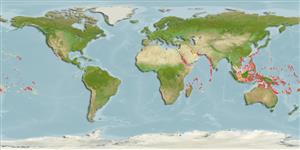Environment: milieu / climate zone / depth range / distribution range
Écologie
marin récifal; profondeur 7 - 27 m (Ref. 9710). Tropical; 30°N - 23°S
Indo-Pacific: Red Sea to the Cook Islands, north to the Ryukyu Islands, south to the northern Great Barrier Reef; Guam and Kapingamarangi in Micronesia.
Taille / Poids / Âge
Maturity: Lm ? range ? - ? cm
Max length : 2.5 cm TL mâle / non sexé; (Ref. 9710)
Description synthétique
Clés d'identification | Morphologie | Morphométrie
Épines dorsales (Total) : 5 - 9; Rayons mous dorsaux (Total) : 7 - 9; Épines anales: 1; Rayons mous anaux: 8 - 9. Dorsal-fin rays VI + I,7-1,9 (usually I,8); anal-fin rays I,8 or I,9 (usually I,9); pectoral-fin rays usually 14-16; scales on body extending forward at most to below interdorsal space, the longitudinal scale series 19-40 (mean count 31); canine tooth present on side of lower jaw; head and body compressed; body depth at origin of anal fin 16-25% SL; snout usually shorter than orbit diameter; gill opening reaching to or anterior to posterior margin of orbit; caudal fin usually slightly emarginate; pelvic fins forming a shallow cup, the spines as fleshy lobes; body transparent in life, except for yellow over abdomen; interorbital and iris bright pink. Largest specimen, 19.5mm SL (Ref. 89154).
Hovers in groups above branches of certain Acropora corals in shallow lagoon reefs, Ref. 48637.
Life cycle and mating behavior
Maturité | Reproduction | Frai | Œufs | Fécondité | Larves
Benthic spawner.
Myers, R.F., 1991. Micronesian reef fishes. Second Ed. Coral Graphics, Barrigada, Guam. 298 p. (Ref. 1602)
Statut dans la liste rouge de l'IUCN (Ref. 130435: Version 2024-2)
Menace pour l'homme
Harmless
Utilisations par l'homme
Pêcheries: commercial; Aquarium: Commercial
Outils
Articles particuliers
Télécharger en XML
Sources Internet
Estimates based on models
Preferred temperature (Ref.
123201): 25.3 - 29.3, mean 28.2 °C (based on 1906 cells).
Phylogenetic diversity index (Ref.
82804): PD
50 = 0.5000 [Uniqueness, from 0.5 = low to 2.0 = high].
Bayesian length-weight: a=0.00724 (0.00339 - 0.01546), b=3.10 (2.92 - 3.28), in cm total length, based on LWR estimates for this (Sub)family-body shape (Ref.
93245).
Niveau trophique (Ref.
69278): 3.0 ±0.3 se; based on size and trophs of closest relatives
Résilience (Ref.
120179): Haut, temps minimum de doublement de population inférieur à 15 mois (Preliminary K or Fecundity.).
Fishing Vulnerability (Ref.
59153): Low vulnerability (10 of 100).
Nutrients (Ref.
124155): Calcium = 445 [186, 1,513] mg/100g; Iron = 1.8 [0.7, 4.2] mg/100g; Protein = 17.6 [15.4, 19.5] %; Omega3 = 0.104 [0.032, 0.332] g/100g; Selenium = 40.1 [10.4, 132.2] μg/100g; VitaminA = 91.4 [15.8, 480.3] μg/100g; Zinc = 4.84 [2.49, 8.34] mg/100g (wet weight);
